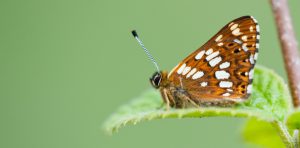Butterfly birthday
March 8, 2018
From water voles to skylarks and wart-biter crickets to sand lizards, many creatures capture the spirit of the National Park. But there’s something special about the South Downs’ butterflies and we’re working closely with Butterfly Conservation to keep it that way.
Words by Chris Lickley and Jo Glyde
The Duke of Burgundy, chalk hill blue and dingy skipper are all butterfly species synonymous with the rolling landscape of chalk and limestone downland but records from 1976-2014 have shown these species, along with many others, in serious decline.
This March marks half a century since charity Butterfly Conservation was founded and as their chair David Attenborough says: “50 years later the need for people who care about our butterflies and moths is greater than ever before.”
The decline in UK butterflies is most likely caused by the loss and fragmentation of their habitats and the resulting drop in wildflower species such as horseshoe vetch, kidney vetch and cowslips, used by the butterflies as both larval food plants and nectar sources. However it’s not all doom and gloom, since the National Park Authority came into existence eight years ago – and before that as the South Downs Joint Committee – our rangers and volunteers have been working in partnership with Butterfly Conservation to support their work in the South Downs and we’re starting to see the results.
The tiny Duke of Burgundy butterfly may not be as spectacular as some other species but it holds a very special place in our hearts. It became one of the first species to benefit from the South Downs’ new National Park status. In 2012, working in partnership with 27 other organisations and local authorities, the National Park Authority was able to secure government funding to improve and join up chalk grassland at key points along the South Downs.
“In 2012 there were fewer than 100 colonies of Duke of Burgundy butterflies left in the UK, most of which were very small and vulnerable,” says Tom Parry, Lead Ranger for the Central Downs part of the National Park. “On peak days of the flight season no more than 5,000 butterflies would be on the wing, and in most years far less. There was little doubt that it would take focussed and determined efforts to save its future.” But the Duke is notoriously picky, preferring cowslips and primroses growing among tussocky vegetation, slightly shaded by scrub on sheltered North or West facing slopes.

Last spring South Downs News covered the work that the people of Steyning, led by the Steyning Downland scheme and supported by Butterfly Conservation’s Neil Hulme, have undertaken to get the Dukes to return to the downland above their town. Not least harvesting 40,000 seeds from primroses & cowslips on the site and then planting out the resulting 3,000 plants in September 2016. We’re waiting with bated breath for the first reported sighting of a Duke of Burgundy here…
Meanwhile at the western end of the National Park the South Downs Volunteer Rangers have spent the past winter working hard at Magdalen Hill Down, Hazel Down, Morn Down and Deacon Hill near Winchester and a big hill named ‘The Mountain’, in West Meon. Here the focus has been on encouraging cowslips to support the Duke of Burgundy. With guidance from local Butterfly Conservation staff Jayne Chapman and Dan Hoare they selectively removed invasive scrub such as bramble, dogwood and blackthorn to create patches of bare ground on areas of sloping grassland. These patches, now exposed to the sun should be colonised by wildflower species critical for butterfly and moth breeding success.
The initial removal of scrub will now be followed up by sheep or cattle grazing to stop scrub regrowing. The volunteer rangers will also help with transect surveys during flight season over the spring and summer.
Meanwhile back in 2015 a project to boost numbers of butterflies and chalk grassland in the South Downs National Park near Brighton unexpectedly saw the return of the silver-spotted skipper butterfly, once close to extinction across the county. The ‘Brighton Blues’ project was set up to improve and increase areas of rare chalk grassland which several species of butterfly such as the Adonis blue and chalkhill blue depend on. But happily reintroducing grazing and clearing encroaching scrub also led to the surprise return of the silver-spotted skipper.

And it’s not just downland butterflies that are benefitting. Work by the South Downs Volunteer Rangers and Butterfly Conservation is helping to save the regionally endangered pearl-bordered fritillary butterfly by creating special havens for this ‘very fussy’ species in woods near Arundel in West Sussex. During the butterfly’s flight period from late April to late May 2017, the highest numbers were spotted flying in the relatively small area cut by the volunteers. On the season’s best day 51 per cent of the 49 butterflies counted across the entire wood were in this area.
As David Attenborough says of the past 50 years: “The fortunes of the UK’s butterflies have ebbed and flowed over this period. Sadly many species have struggled as their habitats have shrunk and climate change and pesticide use have taken their toll. Thanks to Butterfly Conservation a huge number of us now care about butterflies and are aware of their plight and what’s more, we now know how to protect many species and reverse their declines, providing them with a home for the future in the countryside as well as our back gardens.”
We are proud to work with Butterfly Conservation and wish them a bright and fluttery future.
Butterfly Conservation are running events across the country on Saturday 10 March
More about the Steyning Downland Duke of Burgundy project
More about the Brighton Blues project
More about the Fritillaries for the Future project
